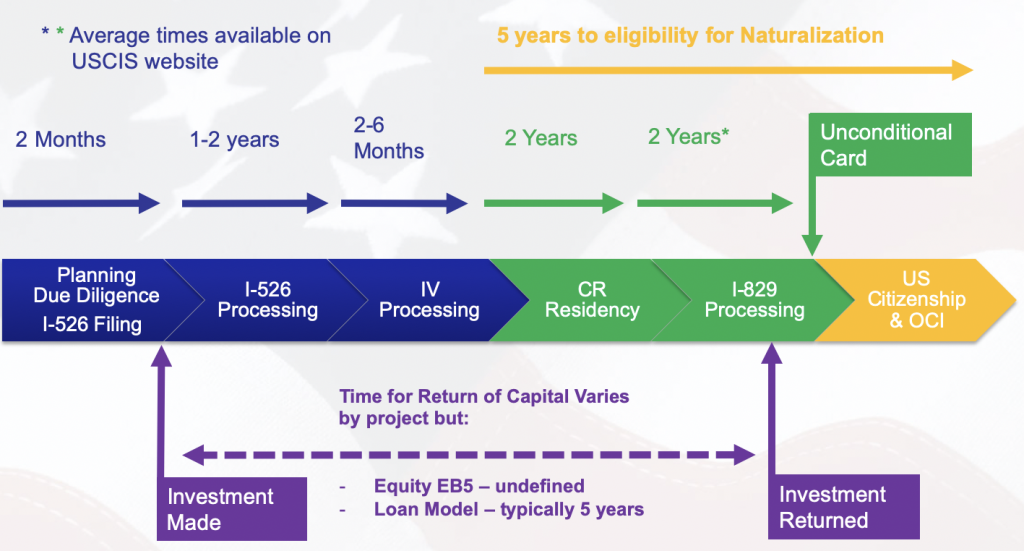WHAT IS EB-5?
The EB5 visa offers US permanent residency in exchange for a minimum $900,000 investment in the United States. It is one of the fastest and most effective routes to a Green Card, which offers freedom to live, work, study or retire anywhere in America.
USCIS administers the Immigrant Investor Program, also known as “EB-5,” created by Congress in 1990 to stimulate the U.S. economy through job creation and capital investment by foreign investors. Under a pilot immigration program first enacted in 1992 and regularly reauthorized since certain EB-5 visas also are set aside for investors in project orchestrated by Regional Centers.
BENEFITS OF EB-5?
- Fast Route to US permanent residency (Green Card)
- Relatively cost-effective compared with other similar countries
- Creates jobs and investment in America
- Freedom to live, work, study and retire in the United States
- The eligible family unit can be included in a single investment
- While capital is at risk, there is a strong chance of getting your money returned if you conduct due diligence on your investment
- Regional Center program offers support with compliance
- Possible to make and manage investment yourself
EB-5 PROCESS & TIMELINE

COUNTRY QUOTAS
There are just over 700 EB-5 visas available to each country each year. If a country exceeds this quota then persons born in that country are subject to a waiting list. The majority of countries are not near using up their quotas, precise per country filing data is available on the Department of State website by clicking here. The EB-5 has proved so popular in China that people born in this country are subject to long delays. EB-5 is also popular in India and Vietnam, which have at times been subject to a delay. Citizens of countries facing quota delays should contact our team to discuss options for living in the United States while on the waiting list.
FAMILY & EB-5
A single EB-5 investment can include an entire qualifying family unit. The eligible family unit can include the primary applicant, a spouse and any children under the age of 21. Planning may be required to ensure that your children do not “age out” of the process. Once you submit your application to USCIS, your childrens’ ages freeze while the approval of your initial petition is pending. Once approved, the children start ageing again from their frozen age rather than their actual age. This means that children could be older than 21, but in the eyes of the US authorities, they are still considered to be under 21. “Aging out” is mostly an issue in countries that face visa retrogression. Ageing Out is a complicated topic and the purpose of this website to provide general guidance only, please contact us to understand this issue in more detail.
WHAT ARE REGIONAL CENTERS?
There are a lot of misconceptions as to what a Regional Center is and is not.
A Regional Center is simply a commercial, for-profit, entity that has applied for and been granted a Regional Center license from USCIS. This does NOT imply that USCIS frequently inspect or warrant any project a Regional Center may offer.
Part of your inquiry into EB-5 will be to conduct full and proper due diligence on any Regional Center you are considering. We have prepared a list of questions you may wish to ask a Regional Center, please contact us to obtain this list.
WHAT IS DIRECT EB-5?
While over 90% of EB5 investments are made in projects sponsored by Regional Centers it is possible to invest in a project that is not offered through a Regional Center. While there is no requirement that you own the business in which you invest it is very common for a business owner to use Direct EB5 to obtain a “Green Card” by investing in his or her own business.
JOB CREATION REQUIREMENTS FOR EB-5
- Create or preserve at least 10 full-time jobs for qualifying U.S. workers within two years (or under certain circumstances, within a reasonable time after the two years) of the immigrant investor’s admission to the United States as a Conditional Permanent Resident.
- Create or preserve either direct or indirect jobs:
- Direct jobs are actual identifiable jobs for qualified employees located within the commercial enterprise into which the EB-5 investor has directly invested his or her capital.
- Indirect jobs are those jobs shown to have been created collaterally or as a result of capital invested in a commercial enterprise affiliated with a regional centre by an EB-5 investor. A foreign investor may only use the indirect job calculation if affiliated with a regional centre.
Note: Investors may only be credited with preserving jobs in a troubled business.

